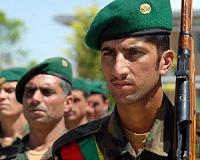| . |  |
. |
Kabul, Afghanistan (UPI) Aug 12, 2010 A recently released U.N. report states that 1,271 Afghans died and 1,997 were injured in the first six months of this year. Three-quarters of these casualties were caused by Taliban forces, mostly from roadside bombings. The Taliban has also continued its practice of carrying out brutal atrocities against civilians. They claimed responsibility for killing members of a civilian medical team in the remote, northeastern province of Badakhshan, which has, until recently, been a relatively peaceful area. At about the same time, in the northwestern province of Badghis, the Taliban killed a 47-year-old pregnant widow accused of adultery. She was flogged 200 times and then shot in the head. The man responsible for impregnating her was apparently not punished. Afghan officials say insurgents are trying to establish strongholds in northern provinces. The insurgents include Pashtun, Tajik, Uzbek and foreign fighters who may be part of the al-Qaida network. Taliban activities in northern Afghanistan could be an effort to pursue several lines of operation including: an effort to demonstrate strength by opening a new war front, attempting to relieve pressure on their forces in the east and south, trying to stretch the coalition forces thin to decrease their effectiveness elsewhere or a campaign to close off northern supply routes. Perhaps all of these. There are also other indications that the Taliban insurgency in Afghanistan may have gone viral. Gilles Dorronsoro of the Carnegie Endowment for International Peace claims that the Taliban has attempted to expand its influence by reaching out to non-Pashtun Afghans who hold similar ideological views. Dorronsoro says the Taliban may have made some progress with the Tatar, Uzbek and Turkmen communities. The Tehrik-i-Taliban Pakistan is the main Pakistani militant group in the Federally Administered Tribal Areas along the Afghan border. It would be an ominous development if Pakistan has struck a deal with the TTP to ignore the insurgents' incursions into Afghanistan as long as TTP doesn't attack Pakistani targets. Such a "peace agreement" would be consistent with the accusations that the Pakistani military spared the Afghan Taliban during last year's operations in the FATA. It is likely that northern Afghanistan represents fertile terrain to advance the insurgency. Long considered one of the more peaceful areas of Afghanistan, a breakdown in security could provide the Taliban with a significant public relations win. In addition, most of the NATO forces deployed in the north are limited by national caveats. These are rules of engagement defined by their governments can restrict certain types of military activities, regulate how much force can be used, when they can use it and may prevent the movement of troops outside of a certain area. Caveats, therefore, can significantly impede combat operations against the Taliban and would require coalition reinforcement of the north, siphoning off critical resources from other regions. Fortunately, northern Afghanistan is dominated by non-Pashtun ethnic groups, which will make it difficult for the Pashtun Taliban to solidify their positions. Nevertheless, it represents a chronic threat if the insurgents can merge their northern operations with those in the volatile eastern region along the porous Pakistan border. Northern Afghanistan may provide a test case for the newly approved Afghan Local Police program. Based on the Afghan tradition of forming temporary village militias, or Arbakai, it could provide protection against Taliban aggression, where there are insufficient Afghan national police and army forces. Persecuted during Taliban rule, northern Afghan tribal groups should be more open to participating in such a self-defense program and provide a bulwark against Taliban advances in that region. Building bottom-up in concentric circles of family, extended family and tribe is the most effective method of creating sustainable security in Afghanistan. (Lawrence Sellin, Ph.D., is a colonel in the U.S. Army Reserve and a veteran of the conflicts in Afghanistan and Iraq. He is currently serving his second deployment to Afghanistan. The views expressed are his own and do not necessarily reflect those of the U.S. Army or U.S. government.) (United Press International's "Outside View" commentaries are written by outside contributors who specialize in a variety of important issues. The views expressed do not necessarily reflect those of United Press International. In the interests of creating an open forum, original submissions are invited.)
Share This Article With Planet Earth
Related Links News From Across The Stans
 Afghan army reaches target strength
Afghan army reaches target strengthKabul (AFP) Aug 11, 2010 Afghan army recruitment has met a target of 134,000 troops two months ahead of schedule, officials said Wednesday, despite a worsening Taliban-led insurgency around the country. The army, backed by billions of dollars from the United States, is aiming to number 171,000 troops by late next year, but an October deadline for 134,000 has already been met, said defence ministry spokesman Mohammad ... read more |
|
| The content herein, unless otherwise known to be public domain, are Copyright 1995-2010 - SpaceDaily. AFP and UPI Wire Stories are copyright Agence France-Presse and United Press International. ESA Portal Reports are copyright European Space Agency. All NASA sourced material is public domain. Additional copyrights may apply in whole or part to other bona fide parties. Advertising does not imply endorsement,agreement or approval of any opinions, statements or information provided by SpaceDaily on any Web page published or hosted by SpaceDaily. Privacy Statement |